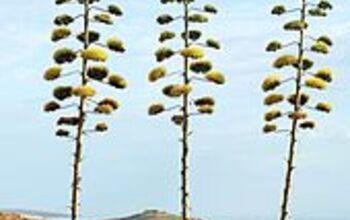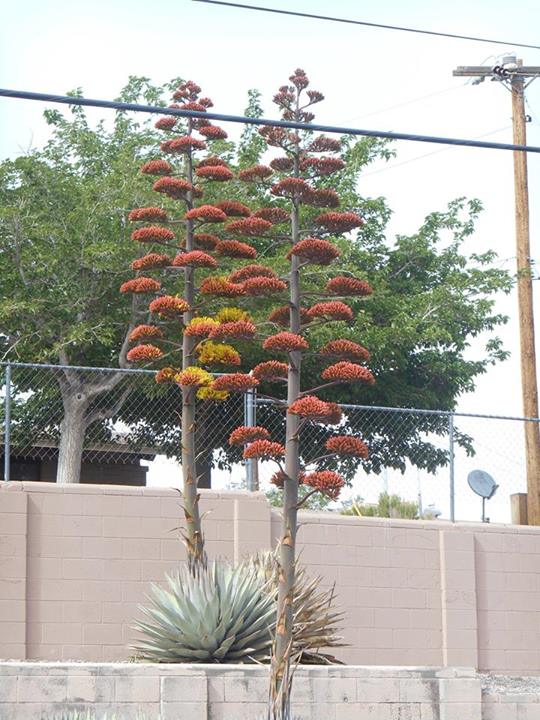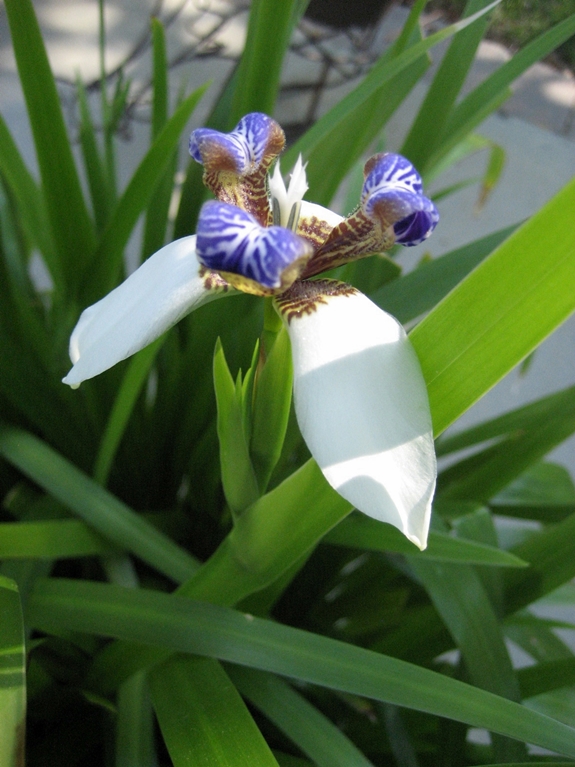Can anyone identify this plant ...some type of century plant perhaps?

-
@Margie, It looks like New Mexico's famous "century plant."
 Lainie
on May 11, 2014
Helpful Reply
Lainie
on May 11, 2014
Helpful Reply -
-
Yes, those are the blooms of Agave americana, and they spell the end of the plant's life.
 Douglas Hunt
on May 11, 2014
Helpful Reply
Douglas Hunt
on May 11, 2014
Helpful Reply- See 2 previous
-
-
I just saw this on the New Mexico Home and Gardening show and Douglas is right. It's an agave and after they bloom they die (sadly). Cool plant!
 Victoria Larsen Stencils
on May 11, 2014
Helpful Reply
Victoria Larsen Stencils
on May 11, 2014
Helpful Reply -
-
Thanks @Lainie, @Douglas Hunt and @Victoria Larsen Stencils that's what I told her I thought it was too, but she told me it's definitely not a century plant ...however I think you are right on with this identification.
 Margie
on May 12, 2014
Helpful Reply
Margie
on May 12, 2014
Helpful Reply -
-
Agave americana, common names century plant, maguey or American aloe,[4] is a species of flowering plant in the family Agavaceae, originally native to Mexico, Arizona and Texas but cultivated worldwide as an ornamental plant. It has become naturalized in many regions including the West Indies, parts of South America, the Mediterranean Basin, parts of Africa, India, China, Korea, Thailand, New Zealand, Australia and an assortment of oceanic islands.[5] Despite the common name "American aloe", it is not closely related to plants in the genus Aloe.
 Pat S
on May 12, 2014
Pat S
on May 12, 2014
 Helpful Reply
Helpful Reply -
-
I just searched "agave in bloom" for images on google and found photos that look exactly like this one so I'm pretty confident.
 Victoria Larsen Stencils
on May 12, 2014
Helpful Reply
Victoria Larsen Stencils
on May 12, 2014
Helpful Reply -
-
Thanks @Pat S and @Victoria Larsen Stencils, I also looked this up online and am pretty positive that all of you 'hit the nail on the head' with that identification ...now I'll just have to convince my friend! LOL Thanks again for the feedback wish we could grow them in Nebraska.
 Margie
on May 12, 2014
Helpful Reply
Margie
on May 12, 2014
Helpful Reply -
-
Doug is right - it is an agave americana. It has an extremely invasive root system - it sends off runners in all directions, so is impossible to get rid of once you have it. It even comes up through roads!
 Valerie
on May 14, 2014
Helpful Reply
Valerie
on May 14, 2014
Helpful Reply -
-
I just saw one of these in AZ. Some friends and I went out to eat and there was one blooming nearby the restaurant. Had no idea that once they bloomed, they died. Interesting!
 Elaine Simmons
on May 14, 2014
Helpful Reply
Elaine Simmons
on May 14, 2014
Helpful Reply -
-
When the stalks are finished with the blooming, they(the stalks) are great to put in your garden as decoration. You can cut them down to the size you want, and even paint they up. So many things you can do with them. I love them.
 Linda Jung
on Sep 13, 2014
Helpful Reply
Linda Jung
on Sep 13, 2014
Helpful Reply -
-
Yep agave or century plants. we have them in NW Florida also.
 Anna Houghton
on Nov 18, 2014
Helpful Reply
Anna Houghton
on Nov 18, 2014
Helpful Reply -
-
As a grower of many types of agave it seems you have a picture of Agave parryi. Hard to tell because there is nothing there to compare the size of it to. Agave americana is more grayish green and grows up to 16 feet wide and 6 feet tall. It is never perfectly symmetrical. Some types of this agave are hardy to 10 degrees F. Agave parryi has the powder blue color like in your photo and grows into a symmetrical artichoke like shape as in your photo. It grows up to 2 1/2 feet wide by 2 feet tall. It is MUCH more cold tolerant, taking it down to -20 F. None of these plants will survive in typical garden soil. Extremely excellent drainage is required. Plant them on a hill full of fine gravel, granite rock dust and concrete sand with a little organic matter mixed in. Fish meal is good fertilizer. A two inch layer of concrete ( hide with gravel ) spread all around will help to keep the agave dry. An agave can collect and feed on water from a rain that came down a mile away. Their roots can grow a mile or more in all directions. Agave will grow and thrive in the strangest places. You can grow them in the crevices between the stubs of cut off palm fronds in the trunks of palm trees. ( start with a tiny pup ). If you receive an agave in the mail please don't stick it in a container of water. It will turn to mush and die quickly. There are infinite varieties of agave. Some grow to only a few inches wide. Others are enormous. Some take many years to produce a pup. Some take many decades to produce a bloom stalk. Others produce a bloom stalk in just a few years. Some have breathtaking variegation. Some have super fat leaves. Others have very skinny and even wiry leaves. They cross breed easily. Many are tropical. Fun plant to research. Please do.
 Artist In The Garden
on Jan 13, 2015
1 marked as helpful Reply
Artist In The Garden
on Jan 13, 2015
1 marked as helpful Reply -
-
Thank you all for your wealth of information! You have opened my eyes to a new kind of foliage. I am living in the the Northeast USA and have never travelled to the desert to see such a thing.
 UpstateNYer
on Jan 21, 2015
Helpful Reply
UpstateNYer
on Jan 21, 2015
Helpful Reply -
-
I live in Truth or Consequences - and yes this is one of our colorful Century plants. This one has great color. There are several varieties locally including some that have variegated leaves. The stalks always signal the death of the 'mother' plant but there are pups around the base.
 Genna Scartaccini
on Jan 21, 2015
Helpful Reply
Genna Scartaccini
on Jan 21, 2015
Helpful Reply -
-
You can harvest the flower/seed stalks near the end of the cycle and dry them and they make super indoor dried flower/plant décor when placed in a large planter/vase.
 Jallen
on Jan 23, 2015
Helpful Reply
Jallen
on Jan 23, 2015
Helpful Reply -
-
I would love to see what the dried seed stalks look like in an arrangement...maybe I can find a pic on line.
 Margie
on Jan 24, 2015
Helpful Reply
Margie
on Jan 24, 2015
Helpful Reply -
-
you seem to know your plant so I was wondering if you could tell me this, I live in eastern Oregon, I have a couple yucca plants which I love. the first set grew this tall trunk out like that and died, I've seen others in the neighborhood that grew a pretty lily like flower at the top. Non of mine ever have. So was it normal for the yucca to get the trunk and die? And why did mine not bloom the flower like the others? Is there a way to cut the trunk when it starts to grow to prevent it from dying?
 Renata
on Jan 25, 2015
Helpful Reply
Renata
on Jan 25, 2015
Helpful Reply -
-
It's an agave for sure. Some people call them Century plants. I have several in my yard in Arizona. One of them bloomed like this, I left the stalk up after bloom, and it produced dozens of new babies (on the stalk!) that I then replanted. The one drawback is that they are frost-sensitive. Mine were hit this year, but are coming back from the centers.
 Diane Dunham
on Feb 09, 2015
Helpful Reply
Diane Dunham
on Feb 09, 2015
Helpful Reply -
-
Mother planted 2 here in North Louisiana. They did well for several years, then we had a really wet year and they both died. Might have to try again by putting it in a raised bed They are really a nice addition to the yard.
 Barbara Kegebein
on Mar 05, 2015
Helpful Reply
Barbara Kegebein
on Mar 05, 2015
Helpful Reply -
Related Discussions
GNATS - How to get rid of them?
Somehow my house and garden got tiny gnats that killed my fuchsia plant and fly everywhere. I have tried ALL the Web recommendations - soap and oil dishes, sand in th... See more
Marigolds growing! Should I pinch the buds?
My marigold plants are growing. I heard that pinching the buds until Autumn will allow them to grow without killing the plant. Is this true?
Growing garlic
Growing our first garlic, should we wait until the leaves are drying out before we pick it? Husband picked first one today along with our first potatoes.
How to keep mice out of your garden?
Hi everyone, I have mice in my garden destroying my vegetables and I have also noticed them in the barn and shed. Please can someone tell me how to prevent them from ... See more
What's the best flower/plant to grow in Texas?
I know that opinions vary, but what's your opinion?!I have great luck w Rosemary plants. Green all year long.
What is the name of this plant?
I was given this plant 8 years ago or so and was told it was an "orchid plant"...not an orchid, but an orchid plant. I was told to keep it potbound and it would bloom... See more
Does anyone know what kind of plant this is?
I have several of these volunteering in various places this year. I don't know what it is and it hasn't bloomed yet. In the picture it's the leafy green one in the mi... See more





